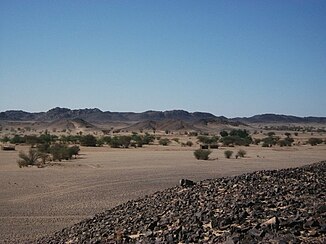Wadi Abu Dom
| Wadi Abu Dom | ||
|
Wadilauf near the micro-oasis at Umm Ruweim |
||
| Data | ||
| location |
|
|
| River system | Nile | |
| Drain over | Nile → Mediterranean | |
| source | Jebel Ras ed-Dom 18 ° 6 ′ 30 ″ N , 33 ° 4 ′ 0 ″ E |
|
| Source height | approx. 540 m | |
| muzzle | at Sanam / Merowe coordinates: 18 ° 29 ′ 24 ″ N , 31 ° 49 ′ 21 ″ E 18 ° 29 ′ 24 ″ N , 31 ° 49 ′ 21 ″ E
|
|
| length | approx. 160 km | |
| mostly dried out | ||
The Wadi Abu Dom is a wadi in Sudan .
course
It rises in the central Bayuda , flows predominantly in a westerly or west-north-westerly direction and flows into the Nile near the ancient city of Sanam , today part of Merowe . The Wadi Abu Dom now only has very irregular water (most recently in the summers of 2009 and 2013).
vegetation
The largest part of the wadi system leads through a desert landscape, only the actual wadi run has acacia and tundub vegetation, which are used by the camel and goat herds of some nomad groups as pasture. The lower course of the wadi, on the other hand, is characterized by several small well-fed oases, in which mainly sedentary farmers live on growing vegetables and dates. Another common in this area is the palm hyphaene that has given the Wadi his name.
archeology
There are numerous archaeological sites along the Wadi Abu Dom, e. B. a large number of cemeteries of different times, especially the Kerma and Napatan epoch, the post-Meroitic period and the Middle Ages . Finds from the Paleo - and Neolithic are also common. Larger ruins are mainly grouped around the oases of the lower Wadi, z. B. Ghazali Monastery and the palace-like structures Umm Ruweim , Quweib and Umm Khafour . The only larger ruin site known so far on the upper reaches of the wadi is el-Tuweina , which can also be addressed as a stately residential building .
The role of Wadi Abu Dom as a historical cultural landscape has been researched since 2009 by an archaeological survey project by the WWU Münster under the direction of Angelika Lohwasser .
literature
- Tim Karberg, Angelika Lohwasser: The Wadi Abu Dom Itinerary (WADI) Survey Project. In: Angelika Lohwasser, Tim Karberg, Johannes Auenmüller eds .: Bayuda Studies. Meroitica 27 , Wiesbaden 2018, pp. 3–119
- Tim Karberg, Angelika Lohwasser: Living and traveling in the Bayuda: The Wadi Abu Dom. In: Sokar - History and Archeology of Ancient Egypt No. 34, 1/2017, pp. 66–77
- Holger Pflaumbaum: Wadi terrace and foot area genesis in the Bayuda Desert (Republic of Sudan). A contribution to the 'morphogenetic sequence' of a marginal tropical arid area , Hamburg 1987
